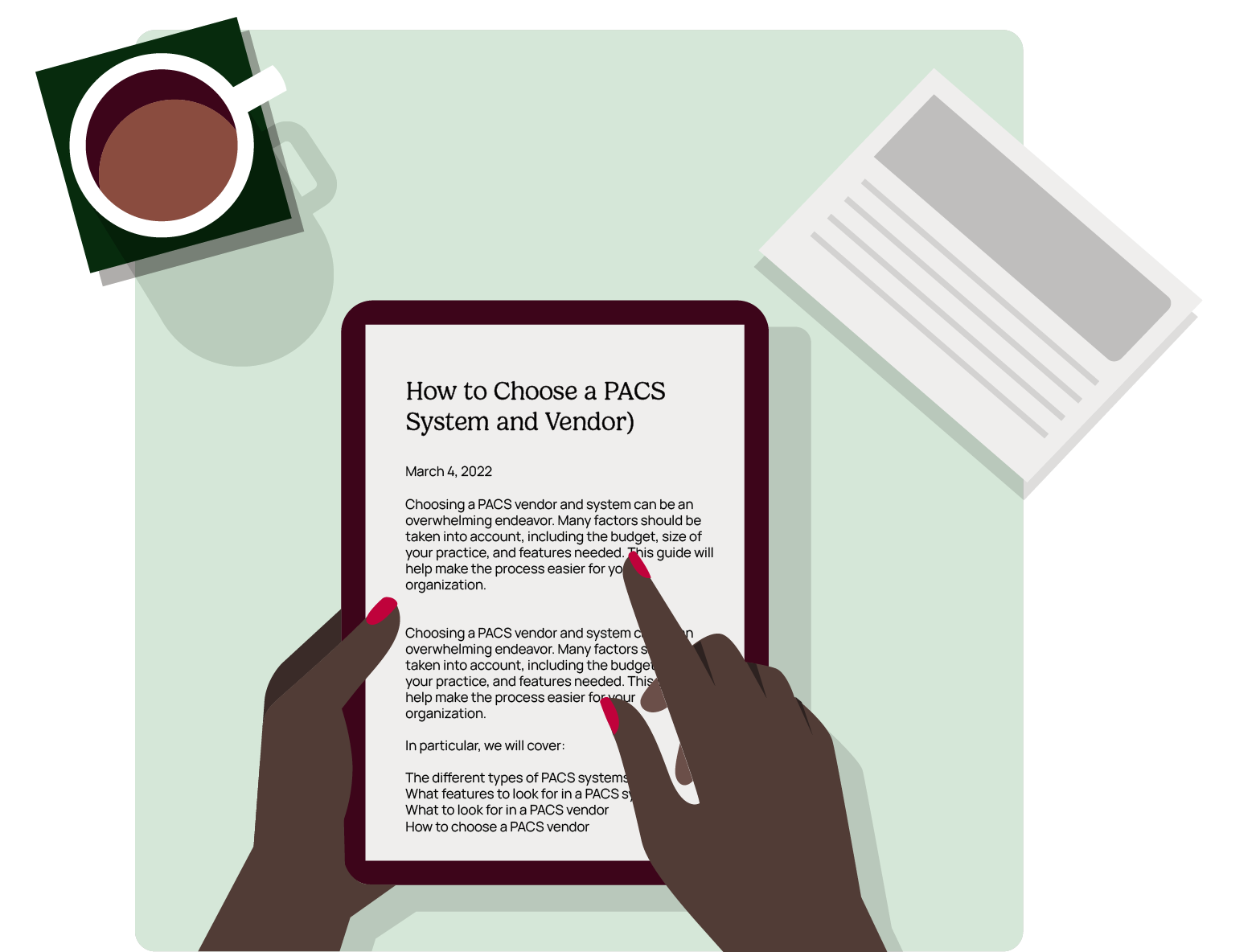March 4, 2022
Choosing a PACS vendor and system can be an overwhelming endeavor. Many factors should be taken into account, including the budget, size of your practice, and features needed. This guide will help make the process easier for your organization.
Choosing a PACS vendor and system can be an overwhelming endeavor. Many factors should be taken into account, including the budget, size of your practice, and features needed. This guide will help make the process easier for your organization.
In particular, we will cover:
- The different types of PACS systems
- What features to look for in a PACS system
- What to look for in a PACS vendor
- How to choose a PACS vendor
Whether your medical practice is just establishing an imaging center or in the market for a new PACS system, there are factors for consideration when selecting a provider. How does your organization determine which system is suitable for your needs? And how do you choose a trustworthy vendor? Here are some best practices in selecting a PACS vendor.
The Challenge
As more medical facilities move to digital imaging and patient data, having a PACS system is ideal for storing sensitive patient information for easy access among the healthcare team. However, many facilities suffer from siloed data as their departments subspecialize imaging modalities.
For example, a hospital can have a PACS system for radiology, another system for cardiology, or another for pathology. These siloed systems can cause a disparity in data usage.
Disciplines such as pathology and dermatology can store non-DICOM data, such as images, videos, and PDFs. When physicians are forced to access various file types in different systems, PACS feels disconnected from electronic medical records (EMR). Attempting to connect the variety of systems can be an expensive endeavor.
Historically, PACS systems are tailor-made for each individual practice, but with evolving healthcare landscapes, growing pains, and regulatory compliance coming into play, the system is not as beneficial to the healthcare practice in comparison to the initial investment.
The Solution
The ideal PACS will allow you to input all of your patient’s information into one system, which can be accessed from any device. It is imperative that this process be quick and easy so it doesn’t cause unnecessary stress during what could already feel like a crisis situation for patients requiring medical attention. Furthermore, the system should be user-friendly. “As with any product purchase, select a system with the users in mind,” explains Anthony C. Toppins M.D., radiologist, CIO, American Radiology Associates, Dallas.
The different types of PACS Systems
There are different system choices to be aware of when choosing a PACS system or PACS vendor.
Traditional PACS
Traditional PACS servers are typically located on-site within hospitals and medical centers. Healthcare IT professionals working in each facility administer the systems that communicate with other PACS systems.
Cloud-based PACS
A Cloud PACS combines the benefits of traditional PACS with the power of cloud infrastructure management. Deployment, support, and system maintenance are facilitated by healthcare IT specialists, leaving healthcare practitioners peace of mind to focus on patient care.
Hybrid systems
Healthcare facilities can also integrate a mixture of the two aforementioned, creating a hybrid cloud system. In a hybrid instance, providers house the primary images on-site, while backup redundancy is hosted in the cloud.
What features to look for in a PACS system
Now that we are familiar with the various types of systems to consider, let’s delve into the features that may be important for your facility, plus questions that should be asked.
Feature Request List
- Storage and management
- Web-based viewer
- Enterprise viewer
- Smart worklists
- Hanging protocols
- Real-time analytics & monitoring
- Integration with EMR
- Customer support and training
- Scalability
Storage and Management
Determining the storage size is fundamental to acquiring a PACS system. Three factors can determine the size needed: study volume, image modality type, and duration. The duration is determined by how long regulations require data to be stored. This could range from 7 to 21 years. Another important factor to consider is whether the storage is centralized or not. Lastly, can all healthcare data be stored and retrieved, including DICOM and non-DICOM formats?
Web-based Viewer
Web access is an increasingly standard feature for PACS systems. Web-based solutions allow access to patient images and data from compatible devices. It also alleviates healthcare IT professionals’ added overhead of maintaining system compatibility since the software is web browser-based. Therefore, an important question to ask in this evaluation is whether images can be viewed from different modalities?
Enterprise Viewer
Does the PACS system offer a highly scalable zero-footprint viewer? The “zero-footprint viewer” simply means there aren’t any software installations on the client device. Using the device’s web browser offers full access to the software as there is no client-side install or download. Additionally, does the system offer ‘zero-trace’ leaving no patient data on the device? More importantly, does the system allow connection to multiple PACS systems regardless of the vendor? Does it support a broad array of medical images? Does it integrate with the medical facility’s patient information systems?
Smart Worklists
Does the solution offer smarter organization of worklists in an automated way, based on the user’s preference? The system should offer a sophisticated assignment engine that ensures cases are assigned to the most appropriate physician, radiologist, or subspecialist.
Hanging Protocols
The system should be easily customizable, allowing users to create their own layouts on the fly. Users should be able to take a snapshot of their workspace, and automatically add it to their collection to share with other users across the enterprise.
Real Time Analytics & Monitoring
Tracking productivity is vital for any workflow. Does the PACS system offer easy real-time analytics and monitoring? The proper analytics toolset provides deep insight into operations. Effectively pinpointing strengths and weaknesses across your imaging chain facilitates a culture of continuous improvement.
Measuring, monitoring, and improving performance can positively impact the healthcare facility’s bottom line. Linda Grdina, an RN, Cardiac Data Manager for BryanLGH Medical Center, verifies the requirement as, “Any time that you can provide physicians with information and reports that are complete and timely, you have increased the opportunity for evaluation and improvement.”
Integration with EMR
It goes without saying, integrating the PACS with the healthcare facility’s EMR (Electronic Medical Record) simplifies operations by streamlining workflows for maximizing return on investment.
Customer Support and Training
Does the PACS vendor provide customer success beyond software updates, troubleshooting, and 24×7 availability? For example, do they essentially partner with your facility, pairing expert support staff to fully educate key users, so there is less likelihood of major support tickets later on?
Scalability
Having a flexible PACS system that scales with your enterprise is crucial. In addition, the system should be able to add on more subspecialties as the practice expands. In a case study, Intelerad helped Florida-based Partners Imaging Centers (PIC) scale a to seven-center radiology practice that reads 60,000 studies per year.
Today, IntelePACS is central to their daily operations, serving as the group’s enterprise-wide
imaging platform for its full network of imaging centers. Over the years, PIC has been able to save lives due to fast reading times since imaging data can be accessed remotely, their staff is lean and productive, which has provided a return on investment. “At the end of the day, my focus is on productivity,” Nigel de Wit, PIC Chief Operating Officer says. “IntelePACS allows our radiologists to read more cases per day. This means the system is paying for itself.”
Does your PACS vendor offer the level of scalability your facility deserves?
What to look for in a PACS vendor
After understanding product features, let’s discuss what solutions the vendor should bring to the table.
- Ease of Use
- Compliance & Security
- Customer Support and Success
- Scalability
- Affordability
Ease of Use
PACS systems and software are meant to enhance the user’s workflow. If the enterprise solution is difficult to use, the experience is counterproductive. Scheduling demos with various vendors is a great way to start. However, we recommend venturing farther by evaluating from other peers.
“Talk to other customers and your peers before making a purchase. I discuss PACS with other radiologists every week and learn something every time,” explains Anthony C. Toppins M.D., radiologist, CIO of American Radiology Associates. “The two best ways to evaluate products are to use them yourself and talk to other users who have more experience with them. Demos are just that– demonstrations. Other users will give you real-world experience that isn’t ‘canned’ or ‘controlled.’ A demo simply doesn’t reproduce the real conditions of any radiology practice or department,” Toppins elaborates.
Compliance & Security
The PACS vendor should operate within your facility’s local compliance guidelines. Furthermore, the systems should adhere to strict security protocols. For example, at Interelad, we follow stringent protocols in virtually every region since we serve a global audience of enterprise clients. See our regulatory compliance statements here.
Customer Support and Success
As previously mentioned, world-class support should naturally be integrated into the vendor’s solution. Having a reliable vendor is key to enabling productivity, efficiency, and high levels of patient care.
Contingency Plan
“Look for a PACS system that has recovery plans for stored data like patients’ information and images taken,” says Daniel Cane, M.D., of ESource Research. Data redundancy is vital for operations and in the case of disaster. Whether your PACS system has a local or cloud-based backup solution, this feature must be required of your selected vendor.
Affordability
Healthcare administrators should consider the total cost of ownership of the PACS system, software, and any ancillary services or equipment that may be associated with the acquisition. There is a matrix of things to consider. We advise the best course of action is to speak with an enterprise solutions provider for a better understanding.
How to choose a PACS vendor
Based on our recommendations, there should be clear criteria for a PACS vendor. The vendor should facilitate your needs now and in the future. No vendor desires to lose clients or gain negative reviews because their systems restrict the healthcare facility from growing.
Intelerad has a proven track record of helping the client’s practice grow, scaling with their operations. For example, we helped PIC grow from one location to a network of seven locations by providing the practice’s medical imaging technology backbone. “With IntelePACS deployed across all seven imaging centers, we are able to operate very efficiently,” said Nigel de Wit. “It is so critical to have a common platform across all locations, and IntelePACS is very quick and efficient.”
Your organization should choose a PACS vendor that offers accessibility, easy-to-use tools, secure software that adheres to all compliance regulations, customer support at the forefront- not as an afterthought, and scalability to support your growth. If your facility seeks all of these asks, try Intelerad enterprise imaging solutions. Contact our sales team for a demo today.
[code_snippet id=5 network=true]





